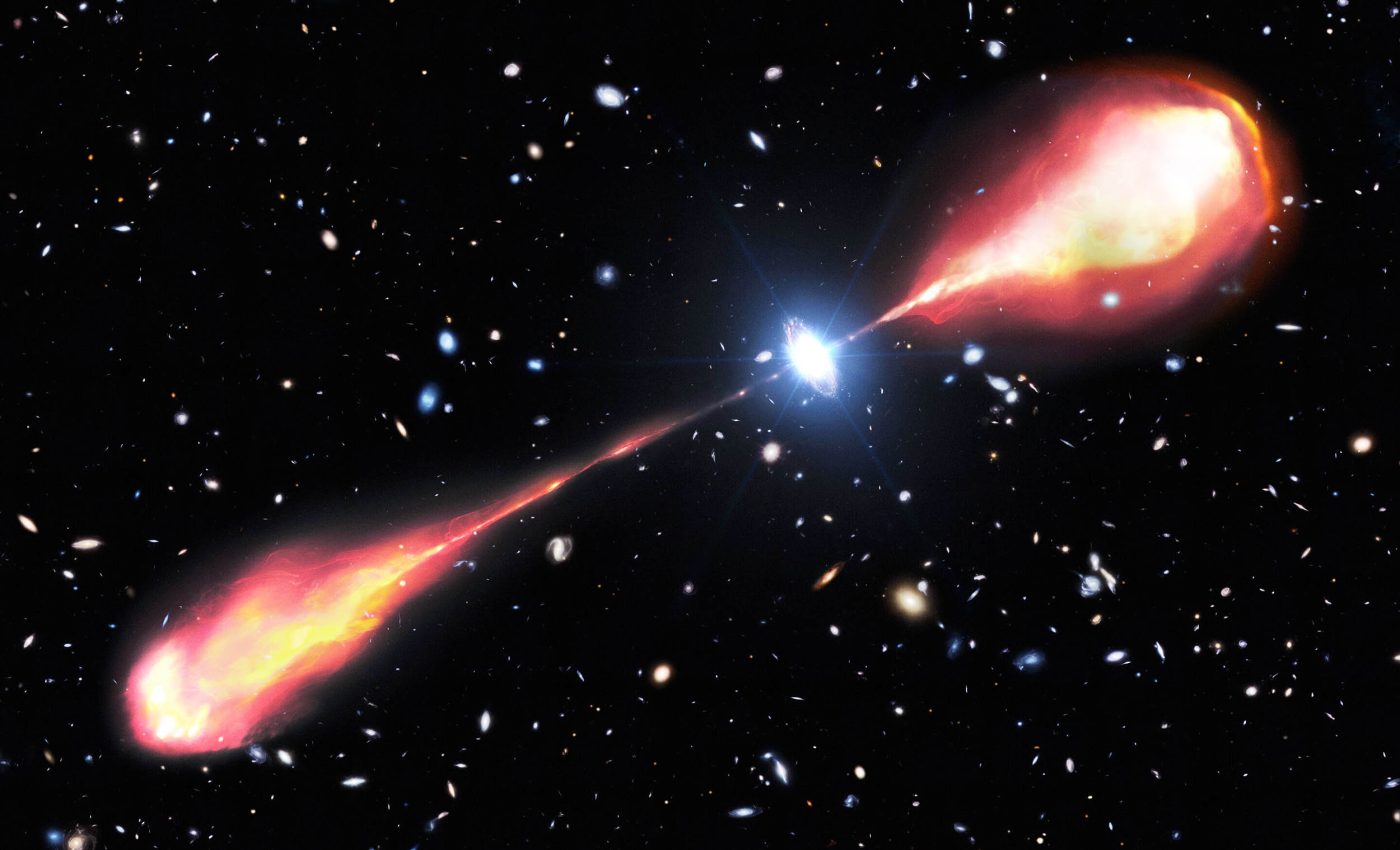
Scientists find the biggest black hole jet ever seen, the size of three Milky Way galaxies
Jets of charged particles race away from some galaxies at nearly the speed of light. They light up radio telescopes and serve as mileposts for how black holes shape the cosmos. Yet beyond a certain distance, the faint signals drown in the microwave hiss left by the Big Bang.
Astronomers have long suspected that many early galaxies carried such jets, but, until recently, even the most sensitive instruments came up empty.
That hurdle has now been cleared. A newly analyzed radio image reveals twin lobes stretching roughly 66,000 light-years on each side of a quasar called J1601+3102.
Because the radio waves began their trip across space more than 12.1 billion years ago, the observation shows the quasar as it was when the universe had completed only about nine percent of its history.
Quasar J1601+3102
This particular quasar, J1601+3102, belongs to a youthful universe – it flared into view when the cosmos was less than 1.2 billion years old.
Even at that early date, its central black hole weighed about 450 million suns, enough to pull in gas and dust that heat up and blast out radiation across the spectrum.
Most radio jets this far away fade before they reach our antennas. The new image, taken with the Low Frequency Array (LOFAR), reveals a structure that spans nearly 200,000 light-years – about twice the Milky Way’s diameter – when both lobes are measured end to end.
The sheer length hints at a sustained engine that kept pumping material well after the first stars lit the universe.
“We were searching for quasars with strong radio jets in the early universe, which helps us understand how and when the first jets are formed and how they impact the evolution of galaxies,” says Anniek Gloudemans, postdoctoral research fellow at NOIRLab and lead author of the study describing the find.
LOFAR provides unusual clarity
LOFAR links more than 50 stations from Ireland to Poland, turning Europe into one giant dish that excels at picking up long-wavelength radio waves.
At those frequencies, even tenuous clouds of electrons glow, so the array can trace the full length of a jet instead of only its bright knots.
“When we started looking at this object, we expected the southern jet to be just an unrelated nearby source, and for most of it to be small. That made it quite surprising when the LOFAR image revealed large, detailed radio structures,” says Frits Sweijen, postdoctoral research associate at Durham University and co-author of the paper.
“The nature of this distant source makes it difficult to detect at higher radio frequencies, demonstrating the power of LOFAR on its own and its synergies with other instruments.”
Teamwork across wavelengths
To fill in the picture, the researchers tapped infrared data from the Gemini North telescope in Hawaiʻi and optical spectra from the Hobby Eberly Telescope in Texas.
These observations located the magnesium emission line that reveals how fast matter spirals toward the black hole and how fast the entire galaxy is receding because of cosmic expansion.

“It’s only because this object is so extreme that we can observe it from Earth, even though it’s really far away,” says Gloudemans.
“This object shows what we can discover by combining the power of multiple telescopes that operate at different wavelengths.”
Large exhaust from J1601+3102
Surprisingly, the engine driving the giant structure is not the hulking monster astronomers expected.
“Interestingly, the quasar powering this massive radio jet does not have an extreme black hole mass compared to other quasars,” says Gloudemans.
“This seems to indicate that you don’t necessarily need an exceptionally massive black hole or accretion rate to generate such powerful jets in the early universe.”
The southern lobe appears stunted, while the northern lobe pushes beyond, hinting that the jet is plowing through clumps of gas left over from early galaxy formation or slamming into a neighboring halo.
Detecting such distant jets is hard because the cosmic microwave background, the afterglow of the Big Bang, grows brighter relative to radio sources as telescopes look farther back in time.
The background robs the lobes of energy and masks weak signals. Only an unusually powerful jet can pierce that fog, which explains why examples have been scarce until now.
What does it all mean?
Each newly spotted jet gives astronomers a fresh line of evidence for how black holes sculpt their host galaxies. By blasting gas out of the center, a jet can slow star formation or, by stirring gas at the edges, trigger more of it.
The discovery of J1601+3102 shows that this give-and-take was already under way when the universe was young, shaping the galaxies we see today.
More sensitive radio surveys and next-generation infrared telescopes promise to find dozens of similar objects in the next few years.
Each will carry a message from a time when space was only dimly lit, telling us how a modest black hole could launch a jet big enough to stretch across three Milky Ways and survive a 12-billion-year journey to our backyard.
The full study was published in The Astrophysical Journal Letters.
Image Credit: NOIRLab/NSF/AURA/M. Garlick
—–
Like what you read? Subscribe to our newsletter for engaging articles, exclusive content, and the latest updates.
Check us out on EarthSnap, a free app brought to you by Eric Ralls and Earth.com.
—–













